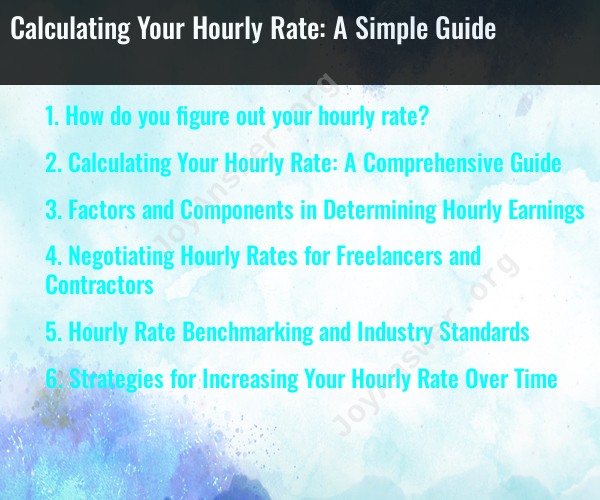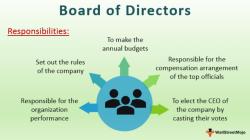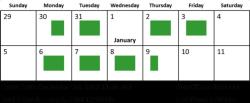How do you figure out your hourly rate?
Calculating your hourly rate involves determining how much you want to earn for each hour of work you provide. This rate can vary based on your profession, experience, skills, and market conditions. Here's a simple guide to help you figure out your hourly rate:
Determine Your Annual Income Goal:
Start by setting a clear financial goal for your annual income. Consider your financial needs, desired lifestyle, and any business expenses you need to cover. Be realistic and specific about the amount you want to earn annually.
Calculate Your Working Hours:
Next, estimate the number of working hours you plan to work in a year. A standard work year is typically around 2,080 hours (40 hours per week for 52 weeks). However, you may need to adjust this number based on factors like holidays, vacation time, and personal preferences.
Consider Expenses and Taxes:
Remember that your gross income (the amount you want to earn) is not the same as your net income. You'll need to deduct expenses, taxes, and other deductions from your gross income to determine your net income.
Adjust for Expenses:
Identify any business expenses you need to cover, such as equipment, office space, insurance, and marketing costs. Deduct these expenses from your gross income to calculate your pre-tax income.
Factor in Taxes:
Determine the tax rate applicable to your income. Self-employed individuals, freelancers, and independent contractors may have to pay self-employment taxes in addition to income taxes. Subtract your estimated taxes from your pre-tax income to find your net income.
Divide by Working Hours:
Divide your net income by the number of working hours you estimated in step 2. This calculation will give you your hourly rate.
Formula: Hourly Rate = Net Income / Estimated Working Hours
Adjust for Additional Factors:
Depending on your circumstances, you may need to adjust your hourly rate for other factors. Consider:
- Market rates: Research what others in your industry or field charge for similar services. Your rate should be competitive.
- Experience and expertise: If you have specialized skills or extensive experience, you may be able to charge a higher rate.
- Location: Rates can vary depending on the cost of living in your area.
- Supply and demand: If there is high demand for your services, you may be able to charge more.
Review and Set Your Hourly Rate:
Once you've calculated your hourly rate, review it to ensure it aligns with your financial goals and market conditions. Adjust your rate as needed to meet your income goals and stay competitive.
Communicate Your Rate to Clients or Employers:
Clearly communicate your hourly rate to clients or potential employers when discussing work opportunities. Transparency about your rate is essential for successful negotiations and agreements.
Remember that your hourly rate may change over time as your skills and experience grow, and as market conditions evolve. It's essential to periodically review and adjust your rate to reflect your changing circumstances and goals.
Calculating Your Hourly Rate: A Comprehensive Guide
To calculate your hourly rate, you need to consider the following factors:
- Your desired annual earnings: How much money do you need to earn each year to cover your living expenses and business costs?
- Your billable hours: How many hours per week can you realistically bill clients?
- Your overhead costs: How much money do you spend each year on business expenses, such as office space, equipment, and marketing?
Once you have considered all of these factors, you can use the following formula to calculate your hourly rate:
(Desired annual earnings - Overhead costs) / Billable hours = Hourly rate
For example, let's say you want to earn $100,000 per year and you have $20,000 in overhead costs. You also estimate that you can bill clients for 2,000 hours per year. Your hourly rate would be calculated as follows:
($100,000 - $20,000) / 2,000 hours = $40 per hour
Factors and Components in Determining Hourly Earnings
A number of factors can affect your hourly earnings, including:
- Your skills and experience: The more skills and experience you have, the higher your hourly rate can be.
- Your industry: Hourly rates vary from industry to industry. For example, freelance software developers typically earn higher hourly rates than freelance writers.
- Your location: Hourly rates can also vary depending on your location. For example, freelance workers in major cities typically earn higher hourly rates than freelance workers in rural areas.
- The demand for your services: If there is high demand for your services, you can charge a higher hourly rate.
Negotiating Hourly Rates for Freelancers and Contractors
When negotiating hourly rates with clients, it is important to be assertive and to know your worth. Be prepared to walk away from a negotiation if you are not offered a fair hourly rate.
Here are some tips for negotiating hourly rates:
- Do your research: Find out what other freelancers and contractors in your industry are charging for their services.
- Be prepared to justify your rate: Be clear about the value that you offer your clients and why you deserve a certain hourly rate.
- Be flexible: Be willing to negotiate on your rate, but don't undervalue yourself.
Hourly Rate Benchmarking and Industry Standards
There are a number of resources available to help you benchmark your hourly rate against industry standards. For example, the Freelancers Union publishes an annual Freelance Rates Report that includes hourly rate data for a variety of industries.
You can also use online tools to benchmark your hourly rate. For example, the Upwork Hourly Rate Calculator allows you to compare your hourly rate to other freelancers on the Upwork platform.
Strategies for Increasing Your Hourly Rate Over Time
There are a number of things you can do to increase your hourly rate over time, including:
- Develop new skills and experience: The more skills and experience you have, the higher your hourly rate can be.
- Expand your network: Networking with other professionals in your industry can help you to find new clients and to learn about new opportunities.
- Market yourself effectively: Make sure that your website and online profiles are up-to-date and that they highlight your skills and experience.
- Provide excellent customer service: Go the extra mile for your clients and deliver high-quality work.
By following these tips, you can calculate your hourly rate accurately, negotiate fair hourly rates with clients, and increase your hourly rate over time.











